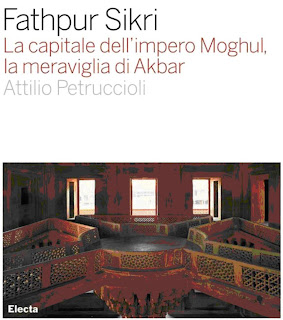 Attilio Petruccioli
Attilio PetruccioliPHOTOGRAPHY BY: Christian Richters
SERIES: Architettura e architetti classici
PUBLISHER: Electa
PAGES: 400
ILLUSTRATIONS: 500
YEAR PUBLISHED: 2007
RELEASE DATE: November
“Because of its political and religious significance, Fatehpur Sikri speaks to the heart of the people of India. At this moment in time, when a centrifugal tendency towards religious and regional particularism is dominant in the country, I think we are duty-bound to offer this evidence”.
Author Attilio Petruccioli thus prefaces the new Electa monograph on the imperial city of Fatehpur Sikri. The city, whose construction was started in 1571 by emperor Akbar, was to be the new capital of the Mogul Empire.
Over the centuries, several cultures have left their traces here, enveloping Fatehpur Sikri in a veil of mystery and lending it a particular charm that has never ceased to attract researchers and archaeologists, as well as the common traveller. However, despite the juxtaposition of elements from different cultures, the entire structure of Fatehpur Sikri can be said to have been designed and built by Akbar, the emperor-architect who is the protagonist of the book.
Author Attilio Petruccioli thus prefaces the new Electa monograph on the imperial city of Fatehpur Sikri. The city, whose construction was started in 1571 by emperor Akbar, was to be the new capital of the Mogul Empire.
Over the centuries, several cultures have left their traces here, enveloping Fatehpur Sikri in a veil of mystery and lending it a particular charm that has never ceased to attract researchers and archaeologists, as well as the common traveller. However, despite the juxtaposition of elements from different cultures, the entire structure of Fatehpur Sikri can be said to have been designed and built by Akbar, the emperor-architect who is the protagonist of the book.
Unlike many Indian monuments, the architecture of Akbar’s palace in Fatehpur Sikri displays a striking combination of elements belonging to different styles, as here for the first time a sophisticated intellectual design is combined with a consolidated popular tradition.
Fatehpur Sikri was constructed in record time, in only fourteen years, between 1571 and 1585. Built by emperor Akbar in honour of Salim Chisti, the famous Sufi saint, it was the capital of the Mogul Empire for slightly more than a decade. It is an extraordinary example of a walled city, entirely built in red sandstone, and includes examples of Hindu and Islamic architecture. The wealth of details and grandeur are particularly impressive in the mosque, the imperial palace, the doors to the city, and the broad public squares.
The author traces the history of Fatehpur Sikri, analysing the architects’ sophisticated planning techniques, based on a natural capacity for joining various architectural elements, a refined sense of geometry, and a great talent in organising work at the construction site. An array of architectural and topographical survey reports and new exclusive photographs gives readers a close-up view of the uniqueness of the red city, which has been declared a Unesco World Heritage Site.
The author traces the history of Fatehpur Sikri, analysing the architects’ sophisticated planning techniques, based on a natural capacity for joining various architectural elements, a refined sense of geometry, and a great talent in organising work at the construction site. An array of architectural and topographical survey reports and new exclusive photographs gives readers a close-up view of the uniqueness of the red city, which has been declared a Unesco World Heritage Site.
The Author:
Attilio Petruccioli is Professor of Landscape Architecture and Dean of the School of Architecture at the Polytechnic University of Bari. He was the Aga Khan Professor for Design in Islamic Societies at Massachusetts Institute of Technology-MIT (1994-1998). He has published several works on Islamic architecture and urbanism and on architecture in developing countries and is editor-in-chief of the Journal of the Islamic Environmental Design Research Centre.
For information Ufficio stampa libri Electa
Tel 02 21563456/441 Fax 02 21563314